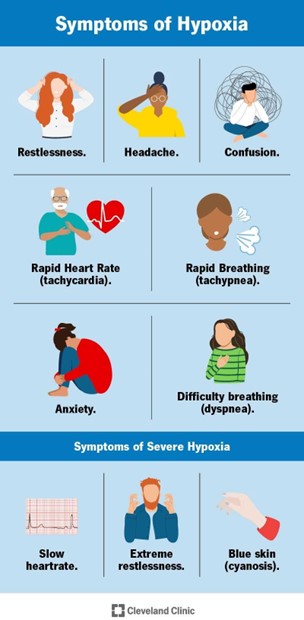The child is a 2-year-old who fell into a pool. He was retrieved from the pool by a family member but was not breathing. The family member started CPR, and the ambulance brought him to the hospital.
What factors are important in determining the level of hypoxemia that the child may have experienced during the submersion?
Select all that apply.
Temperature of water
The weight of the child
Oxygen concentration of the ambient air
Whether or not anyone witnessed the fall into the pool
The amount of time the child was submerged
Correct Answer : A,E
The level of hypoxemia that the child may have experienced during the submersion depends on several factors, but the most important ones are:
- The **temperature of water**: Cold water can induce a diving reflex, which lowers the heart rate and oxygen consumption, and may protect the brain from hypoxic injury. Cold water can also cause laryngospasm, which prevents water aspiration but also impairs gas exchange.
- The **amount of time the child was submerged**: The longer the submersion, the more severe the hypoxemia and the higher the risk of brain damage and death. The survival rate decreases significantly after 5 minutes of submersion.
The other factors are less relevant or not directly related to the level of hypoxemia:
- The **weight of the child**: This may affect the buoyancy and the ability to float or swim, but not the oxygen consumption or gas exchange during submersion.
- The **oxygen concentration of the ambient air**: This may affect the pre-submersion oxygen saturation, but not the rate of oxygen depletion or gas exchange during submersion.
- The **witnessing of the fall into the pool**: This may affect the time to rescue and resuscitation, but not the level of hypoxemia during submersion.

Nursing Test Bank
Naxlex Comprehensive Predictor Exams
Related Questions
Correct Answer is B
Explanation
Choice A rationale:
The statement, "This medication will shorten the duration of my symptoms," is correct. Oseltamivir is an antiviral medication used to treat influenza, and it can reduce the duration of symptoms when taken early in the course of the illness.
Choice B rationale:
The statement, "This medication will prevent me from spreading the virus to others," is incorrect. While oseltamivir can help reduce the severity and duration of symptoms, it does not prevent the spread of the virus to others. Clients with influenza should still take precautions to avoid transmitting the virus to others.
Choice C rationale:
The statement, "This medication will work best if I start taking it within 48 hours of symptom onset," is correct. Oseltamivir is most effective when started within 48 hours of the onset of symptoms.
Choice D rationale:
The statement, "This medication may cause nausea and vomiting as side effects," is correct. Nausea and vomiting are potential side effects of oseltamivir, and clients should be informed about these possible adverse reactions.
Correct Answer is B
Explanation
Choice A rationale:
Increasing the supplemental oxygen to 15 L/min via nasal cannula may seem like a logical step given the client’s low oxygen saturation. However, it’s important to note that oxygen therapy should be titrated carefully. Too much oxygen can lead to oxygen toxicity, which can cause cellular damage and worsen the client’s condition. Therefore, this is not the priority action.
Choice B rationale:
Notifying the health care provider of the client’s condition is the priority action. The client’s oxygen saturation is 88% on room air, which is below the normal range of 95% to 100%. This indicates that the client is not getting enough oxygen, which can lead to hypoxia and other serious complications. The health care provider needs to be informed immediately so that appropriate interventions can be initiated.
Choice C rationale:
Administering ibuprofen as ordered for fever is important, but it’s not the priority in this situation. While fever can indicate an infection, which could be contributing to the client’s low oxygen saturation, addressing the immediate issue of hypoxia is more critical.
Choice D rationale:
Obtaining a sputum culture from the client could provide valuable information about the type of bacteria causing the pneumonia and guide antibiotic therapy. However, this is not an immediate priority compared to addressing the client’s low oxygen saturation. In summary, while all these actions are important in caring for a client with pneumonia, the nurse must prioritize interventions based on their urgency and potential impact on the client’s health status. In this case, notifying the health care provider of the client’s condition is the most critical action.
Whether you are a student looking to ace your exams or a practicing nurse seeking to enhance your expertise , our nursing education contents will empower you with the confidence and competence to make a difference in the lives of patients and become a respected leader in the healthcare field.
Visit Naxlex, invest in your future and unlock endless possibilities with our unparalleled nursing education contents today
Report Wrong Answer on the Current Question
Do you disagree with the answer? If yes, what is your expected answer? Explain.
Kindly be descriptive with the issue you are facing.
